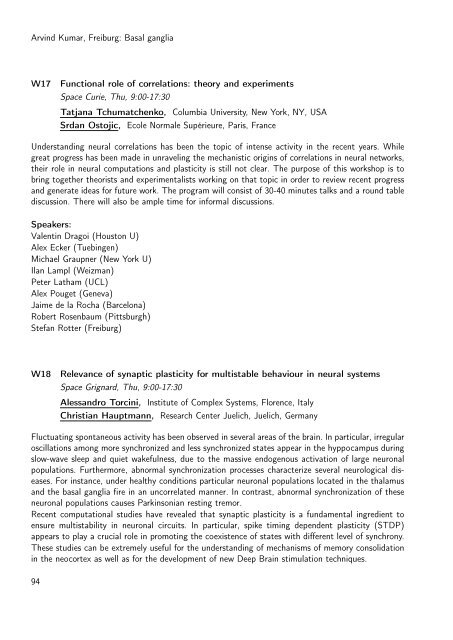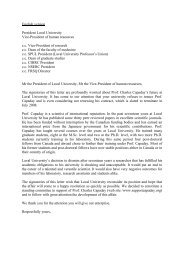Untitled - Laboratory of Neurophysics and Physiology
Untitled - Laboratory of Neurophysics and Physiology
Untitled - Laboratory of Neurophysics and Physiology
Create successful ePaper yourself
Turn your PDF publications into a flip-book with our unique Google optimized e-Paper software.
Arvind Kumar, Freiburg: Basal ganglia<br />
W17<br />
Functional role <strong>of</strong> correlations: theory <strong>and</strong> experiments<br />
Space Curie, Thu, 9:00-17:30<br />
Tatjana Tchumatchenko, Columbia University, New York, NY, USA<br />
Srdan Ostojic, Ecole Normale Supérieure, Paris, France<br />
Underst<strong>and</strong>ing neural correlations has been the topic <strong>of</strong> intense activity in the recent years. While<br />
great progress has been made in unraveling the mechanistic origins <strong>of</strong> correlations in neural networks,<br />
their role in neural computations <strong>and</strong> plasticity is still not clear. The purpose <strong>of</strong> this workshop is to<br />
bring together theorists <strong>and</strong> experimentalists working on that topic in order to review recent progress<br />
<strong>and</strong> generate ideas for future work. The program will consist <strong>of</strong> 30-40 minutes talks <strong>and</strong> a round table<br />
discussion. There will also be ample time for informal discussions.<br />
Speakers:<br />
Valentin Dragoi (Houston U)<br />
Alex Ecker (Tuebingen)<br />
Michael Graupner (New York U)<br />
Ilan Lampl (Weizman)<br />
Peter Latham (UCL)<br />
Alex Pouget (Geneva)<br />
Jaime de la Rocha (Barcelona)<br />
Robert Rosenbaum (Pittsburgh)<br />
Stefan Rotter (Freiburg)<br />
W18<br />
Relevance <strong>of</strong> synaptic plasticity for multistable behaviour in neural systems<br />
Space Grignard, Thu, 9:00-17:30<br />
Aless<strong>and</strong>ro Torcini, Institute <strong>of</strong> Complex Systems, Florence, Italy<br />
Christian Hauptmann, Research Center Juelich, Juelich, Germany<br />
Fluctuating spontaneous activity has been observed in several areas <strong>of</strong> the brain. In particular, irregular<br />
oscillations among more synchronized <strong>and</strong> less synchronized states appear in the hyppocampus during<br />
slow-wave sleep <strong>and</strong> quiet wakefulness, due to the massive endogenous activation <strong>of</strong> large neuronal<br />
populations. Furthermore, abnormal synchronization processes characterize several neurological diseases.<br />
For instance, under healthy conditions particular neuronal populations located in the thalamus<br />
<strong>and</strong> the basal ganglia fire in an uncorrelated manner. In contrast, abnormal synchronization <strong>of</strong> these<br />
neuronal populations causes Parkinsonian resting tremor.<br />
Recent computational studies have revealed that synaptic plasticity is a fundamental ingredient to<br />
ensure multistability in neuronal circuits. In particular, spike timing dependent plasticity (STDP)<br />
appears to play a crucial role in promoting the coexistence <strong>of</strong> states with different level <strong>of</strong> synchrony.<br />
These studies can be extremely useful for the underst<strong>and</strong>ing <strong>of</strong> mechanisms <strong>of</strong> memory consolidation<br />
in the neocortex as well as for the development <strong>of</strong> new Deep Brain stimulation techniques.<br />
94



